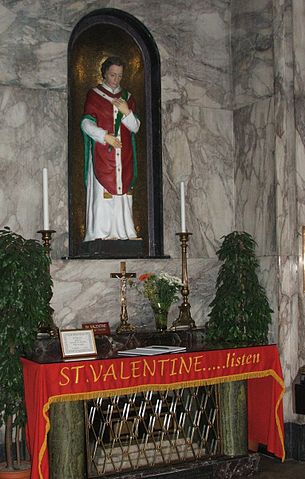
Photo: Blackfish (Wikimedia Commons)
Valentine’s Day is used by many to show their affection or love for someone they care about. It has spawned an industry for greeting card makers, candies, and of course flowers. However, there is a real religious component as many Christian denominations celebrate it as feast day, commemoration, or optional for the local diocese (such as the Catholic Church). Valentine was the name of many Christian martyrs in the early Church resulting in them all being remembered for their acts of sacrifice for the faith. Some denominations, such as Eastern Orthodox Church, celebrate a particular St. Valentine on two different days.
The association with romantic love could be linked to an ancient Roman festival has been made but there is no evidence of any link. Most seem to believe the link began with Chaucer’s Parlemont of Foules where he indicates birds choose their mates on St. Valentine’s Day although 14 Feb might not be the day Chaucer was referring to. Other poems made the association of love and St. Valentine’s Day in the medieval period and English Renaissance. For those who needed love verses but lacked the ability to compose them, publishers started offering them. Then putting them on paper and sending them became possible. Paper valentines became very popular in 19th century England resulting in their industrial production. They became popular in the United States as well. With such cards being popular, you needed other things to accompany a card. Roses and chocolates became popular, likely due to skillful marketing to associate them with the day. And so, Valentine’s Day became a very major day for greeting card companies, chocolate makers, and sellers of flowers (roses being the most popular flower for the day).
But Who Was Saint Valentine?
Saint Valentine is a Christian martyr who died in the 3rd century on April 14 but owing to the confusion there were at least three people named Saint Valentine, his actual history is lacking. One Saint Valentine was a priest and physician in Rome who was martyred in 270 AD under the reign of Claudius II Gothicus (reigned 268-270 AD). He was buried on the Via Flaminia and a basilica was reportedly put over it by Pope Julius I. Archaeological excavations have shown that a found evidence of the tomb. During the thirteenth century his relics were moved to the Church of Praxedes near the Basilica of St. Mary Major where they are today. A small church built near the Flaminian Gate (today called Porta de Popolo) was called in the twelfth century “the Gate of St. Valentine” adding more weight to this Saint Valentine.
The second Saint Valentine was reportedly the bishop of Terni, Italy (Interamna at the time). He too was arrested and martyred during the same emperor. However, it is not clear whether he was executed in Rome or in Terni. Some argue that St. Valentine I and Saint Valentine II are the same person and the accounts got jumbled up. There has been confusion in the past with two people who became saints sharing the same name. Usually, they have something extra added to differentiate (St. John of the Cross vs. St. John of Damascus). It is possible that there were two men named Valentine, one a priest in Rome and the other in Terni. We simply have no way of knowing.
The third St. Valentine was martyred in Africa along with his companions during the same period and possibly under the same emperor. In this case, there is nothing further known at all. Just a mention of it and no one can say for sure whether this is true or not. With three St. Valentine’s all claiming to have suffered martyrdom, all the church can say is that they died as martyrs for their faith. In 1969 St. Valentine was removed from the general Roman calendar making the commemoration of his feast day optional. As in the case of all saints so designated, it is up to the local bishops to decide whether to it observed. For example, the feast of St. Patrick is a solemnity in Ireland and in the diocese of New York but not elsewhere. St. Valentine is still considered a martyr by the Catholic church.
Sources
“Saint Valentine | Facts, Patron Saint of, Feast Day, History, and Legends.” Encyclopedia Britannica, 13 Feb. 2024, www.britannica.com/biography/Saint-Valentine.
“Saint Julius I | Roman Bishop, Church Father, Defender.” Encyclopedia Britannica, 20 July 1998, www.britannica.com/biography/Saint-Julius-I.
“Valentine’s Day 2024: Origins, Background and Traditions | HISTORY.” HISTORY, 22 Dec. 2009, www.history.com/topics/valentines-day/history-of-valentines-day-2.
Saunders, William Father | History of St. Valentine. www.catholiceducation.org/en/culture/catholic-contributions/history-of-st-valentine.html.

